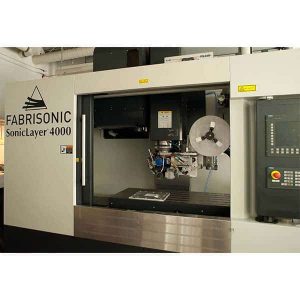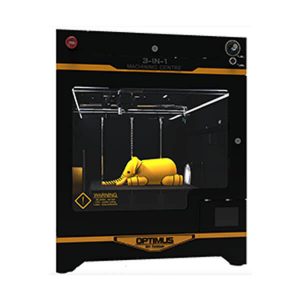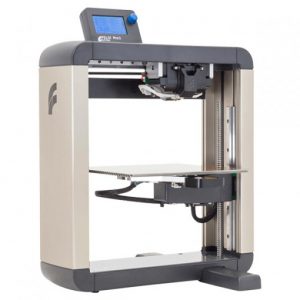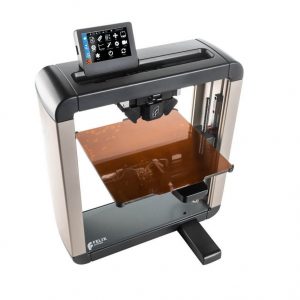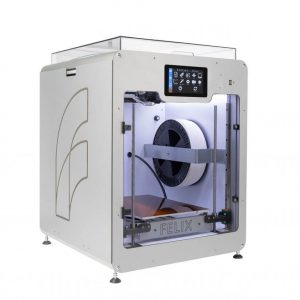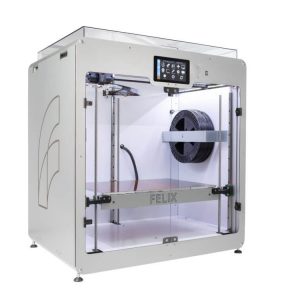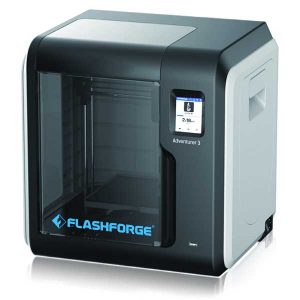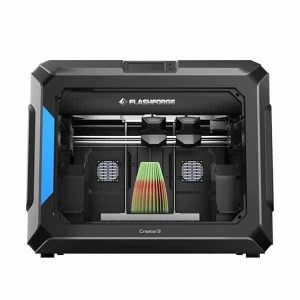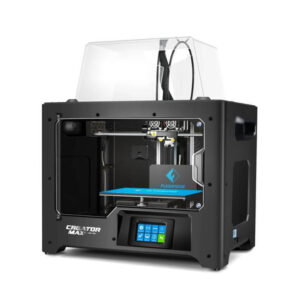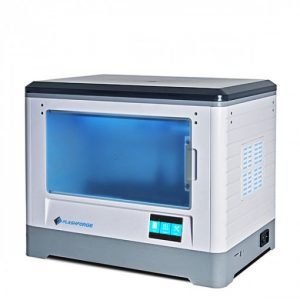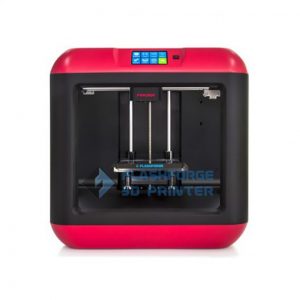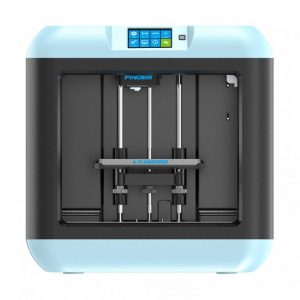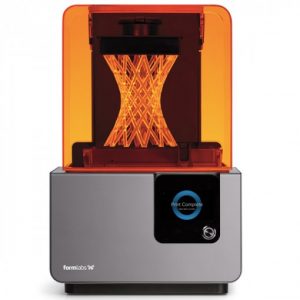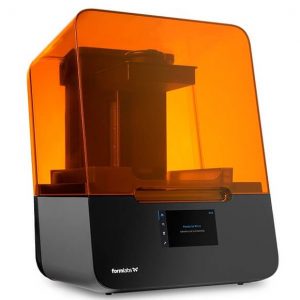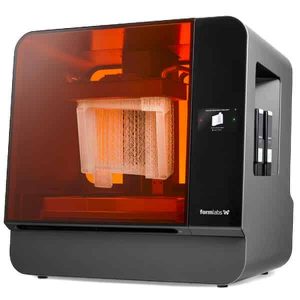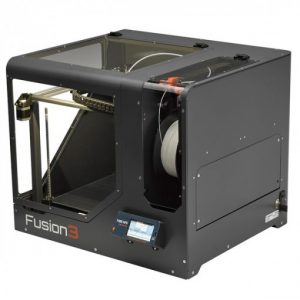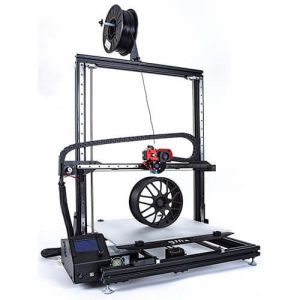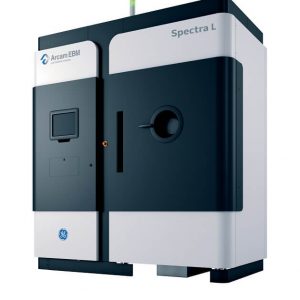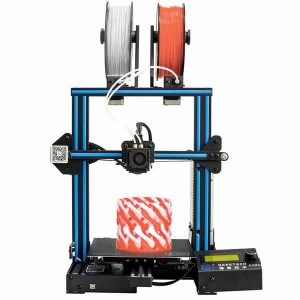Filter
Showing 91–120 of 285 results
PROS:
- High-speed process for additive manufacturing.
- Large available envelope for substantial size parts.
- No melting characteristics.
- Bonding of dissimilar metals.
- Metal matrix composites.
- Smart or reactive structures.
- Low-temperature process.
- Complex internal geometries.
- Requires no post-processing on parts and functional prototypes.
CONS:
- Cost is a huge issue with every industrial printer and Fabrisonic Sonic Layer 4000 falls in that range. So no one can help it when users are more concerned about cost than quality and quantitative manufacturing in less time.
PROS:
- Huge build volume.
- Commendable 3D printing quality.
- Closed print chamber.
- Allowed to play with various materials.
- Three in one operation.
CONS:
- The printer proves to be very much compact for first-time users. To deal with three different mechanisms for making a part turns out to be much of a hassle because of space issues.
PROS:
- Comes with dual extruders
- You can connect using USB and micro SD cards
- Allows use of third party filaments
- It is open-sourced
- The print bed is completely removable
- It has a touch screen interface
- Allows printing with various materials
CONS:
- Pro 2 has an open body because of which it can be subjected to danger if kids are around
- The temperature of the atmosphere will affect the overall quality of the print so some complex geometries can not be printed with dimensional accuracy
PROS:
- Comes with swappable print heads.
- Has a dual extruding system.
- Parts and prototypes of larger volumes can be printed using Felix Pro 3.
- Accommodates a touch screen on its top for monitoring and controlling.
- It comes with multiple options to connect.
CONS:
- The printer has an open body because of which temperature stability is an issue.
- The safety of parts, while they are in the printing process, is also an issue.
PROS:
- Huge build volume.
- Intuitive touch screen interface.
- Wifi-connectivity.
CONS:
- Enclosed chamber printing.
PROS:
- Huge Build volume.
- Removable and bendable flexplate.
- Dual extrusion system.
- High-quality surface finish.
- Dimensional accuracy even in intricate parts and functional prototypes.
CONS:
- Enclosed print chamber.
- Post-processing of part is difficult because cooling takes more time than in any open-body 3D printer.
PROS:
- Optional dual extruders.
- Flexible build plates.
- Semi-automatic leveling.
- Heated bed.
CONS:
- Open body.
PROS:
- Third-party filaments are supported in the printer
- The printer has a user-friendly touchscreen display
- There’s a filament runout sensor in Adventurer 3 that’s coupled with a resume print feature that allows parts to resume printing exactly from the same point from which they were left off after changing filaments
- Multiple connectivity options in Adventurer 3 include USB, Wi-Fi, ethernet, and cloud printing
CONS:
- The build plate can move around too much and sometimes cause the part to fail so it has to be calibrated before printing which takes a lot of time every time!
- The instruction manual that comes with this printer can be confusing to get through
- The Wi-Fi connection is known to present some issues while updating the software
PROS:
- Independent dual extrusion system.
- Built-in camera.
- Can be monitored from anywhere.
CONS:
- Compact in size, small build volume.
- Enclosed body.
PROS:
- Dual extrusion.
- Considerable build volume.
- Easy to set up.
- Decent print speeds.
CONS:
- Printing support materials is a little confusing.
- It’s difficult to deal with the SD card slot and there are complaints about the way it functions.
PROS:
- Pre-Assembled
- Decent Print Quality
- Dual Extruder
- Affordable
- Heated Bed
CONS:
- No Auto Calibration
- A Bit Noisy
PROS:
- Easy to assemble.
- Dual extrusion.
- Considerable build volume.
- Extraordinary speed.
- Good resolution in prints.
CONS:
- The enclosed chamber restricts the user’s freedom.
- Filament jamming is reported as a problem by many users.
- Printing with ABS is a little bit problematic.
PROS:
- Removable build plate
- Quiet operation
- Simple and impressive design
- User-friendly touchscreen interface
- Very Reliable
- Overhead light for enhancing the visibility of prints
CONS:
- Tiny build space
- Non-heated print bed
- Lack of auto-leveling feature
- Only supports PLA
- Tricky when working with support structures
PROS:
- Easy to setup
- Assembled and compact
- Removable Bed
- Assisted bed leveling
- Affordable
CONS:
- No automated calibration
- Only prints with PLA
- Not suitable for professionals or serious users
PROS:
- Auto-bed leveling.
- Amazing print speed.
- Extraordinary print quality.
- Considerable build volume.
- Titan extruder.
- 32- bit motherboard.
CONS:
- The non-moving print head makes it difficult to make certain intricate parts and functional prototypes.
PROS:
- Provides excellent print quality
- Hassle-free setup and first test print
- The combination of hardware and software is amazing, and their tuning is awesome.
- Great slicer software
- Nice user interface
- Relatively noise-free operation
CONS:
- Post-processing is a must for every print.
- Speed isn’t fast when compared to the FDM printers.
- Changing resin is difficult and messy
- Consumables cost such as resin price and tank price are expensive
Editor choice
PROS:
- The print speed is fast as compared to its predecessor
- The surface quality is improved
- Controlled monitoring is available
- Price is decent when compared to the other SLA printers
- Advanced SLA technology coined as Lower Force Stereolithography
- Closed body, hence safe
- Good quality prints
CONS:
- Need support structure for prints
- Post Processing Requirement
PROS:
- Easy to learn and operate
- Offers great accuracy and precision
- Compact design
- Auto-generated support
- Light touch removal of support
- High surface quality
CONS:
- A little expensive
- Post-processing required
PROS:
- Produces fine quality orthodontics model without any interruption.
- Minimal cost per part.
- Robust 3D printing system.
- Enclosed build chamber.
- Able to print with biocompatible resins.
CONS:
- Small build volume.
PROS:
- Reduced Peel Forces providing better quality prints
- High-speed printing
- Economical price for an SLA based technology (LFS)
- Automatic bed leveling
- Plug and Play use
- Light support easy to remove;Constant Monitoring
CONS:
- Post Processing Requirements
- Expensive than low prices FDM machines
- Support structure required for every design
PROS:
- Bigger built volume.
- Removable chamber.
- The printer produces amazing prints in parts and prototypes that are manufactured using it.
- It has a layer thickness which is probably the most minimal.
- Available at an affordable price.
CONS:
- Not very fast print speed.
PROS:
- Large build space;2 years of warranty
- Easy to operate with automatic bed leveling
- High-quality prints
- High speed
- Value for money
CONS:
- Missing dual extruder
- The expensive choice for beginners
PROS:
- Large build space
- Automatic bed leveling
- Great print quality
- Fast speed up to 250mm per second
- Sturdy design
- Three interchangeable nozzles
- Remote monitoring through an ethernet connection
CONS:
- Lack of WIFI connection
- Not affordable for home users
PROS:
- Extensive filament options.
- Genuine E3D All metal hotend.
- Massive build volume.
- Industrial Strength Frame.
- Integrated heated bed and BuildTak.
CONS:
- Temperature generation might be an issue due to the open frame structure of the printer.
PROS:
- Highly productive.
- Reduces cost per part by 10 percent.
- Powered by highly effective 4.5 Kilowatt electron beam.
- Capable of mass-producing.
- Amazing design freedom.
- Able to print faster.
- Comes with an efficient PRS-30.
CONS:
- The printer and its components take up huge space so users will have to have a good amount of infrastructure dedicated for this giant piece of industrial 3D printer.
PROS:
- The machine is capable of maintaining powder integrity to ensure optimal part production;
- It features a 100% increase in power as well as 50% faster build times
- Withstand higher heat more than 1000 degree Celsius allowing the incorporation of more alloys
- Allow larger parts 3D printing and more numbers of parts at a time
- Automating most of the processes that needed manual intervention before and providing optimal quality control
- Faster speed and takes lesser time for production
- Increased part printing quality
- User-friendly and simplified processes introduction for operators
- Easy to validate and improvement in the uptime
- Increased efficiency
CONS:
- Post-processing requirement
- Not compatible with plastic or polymer or ceramic materials
- Expensive and huge in size
- Specific to industrial use
PROS:
- Automatic bed leveling.
- Colour mixer.
- Dual extruder system.
- Filament Sensor.
CONS:
- The printer has an open system because of which temperature generation could be an issue, especially while printing with materials such as ABS.
PROS:
- Easy to setup
- The operation is also easy making it a convenient choice for beginners too
- It can engrave on a huge choice of materials, hence, highly versatile
- It is safe to use and comes with a fully enclosed frame
CONS:
- It does have a bulky design
- The printer won’t work without a WIFI connection at all
- It is noisy and produces smell as well
Editor choice
PROS:
- The printer is very compact and easy to manage.
- Accurate and reliable.
- Pre-assembled.
- Provides automatic bed leveling
- Factory calibrated
- It uses the 60W UV LED to process the prints faster.
- The print quality is awesome.
- Offers wired as well as a wireless connection for uploading the 3D models.
- You also get to enjoy the hassle-free smartphone remote control.
CONS:
- The consumable cost is higher. And, this includes the FEP film that wears off with time and regular use. You do get a replacement but aren’t always in the perfect size. You will need to employ extra efforts in cutting the film to the required size.
- Build space is too low.
PROS:
- Delivers quality output.
- Up to 10 times faster at half the cost.
- Delivers fine detail and dimensional accuracy.
- Lets you have accurate thermal control of every layer and enables predictive corrections voxel by voxel for optimal mechanical properties.
- Low cost per part and minimal powder wastage.
- Reduces cooling time which results in faster time to part and more parts ready within the same day.
- Enclosed unpacking and material collection system.
- Automated material mixing and loading systems.
CONS:
- This printing system demands a huge one-time investment which not everyone will be able to pay. And so the accessibility of this wonderful printing technology and the machine is still a huge question.

